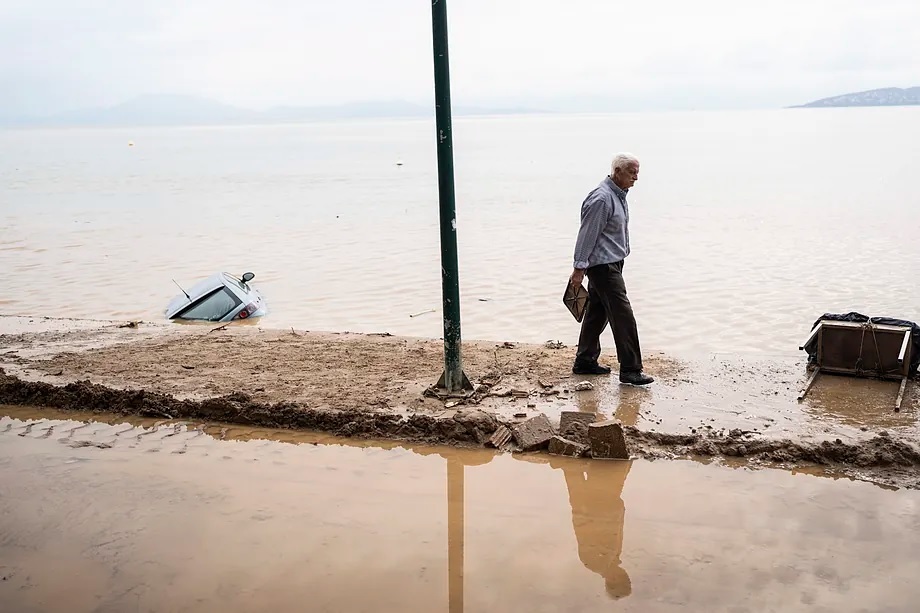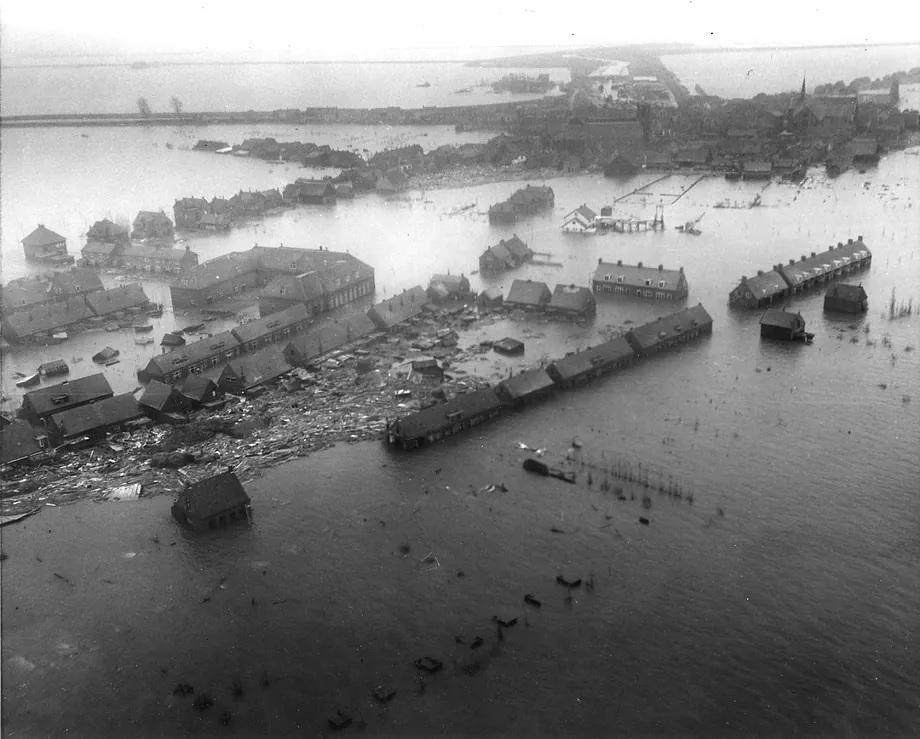The Old Continent has had to face in its long life large-scale natural disasters and catastrophes with serious consequences: fires, earthquakes, floods, and heatwaves that left behind thousands of dead, but also served to learn, adapt, and reduce the number of victims when nature struck again.
The catastrophic DANA that has hit Valencia has had an extraordinary impact, but it is not the first time that hundreds of victims have occurred in Spain. The record is held by the flood in El Vallès in 1962, with an estimated thousand deaths. A staggering number that is even small compared to the tens of thousands of deaths recorded in some of the worst natural disasters that shook Europe in its recent history. These disasters that come to mind these days remind us of the need to be prepared and to prevent. October 29, 2024 is now part of that black list where nature wrote a new chapter of its history with pain and suffering.
North Sea Flood (1953)
During the night between January 31 and February 1, 1953, a major storm caused one of the greatest disasters in the history of the European continent. More than 2,500 deaths, 160,000 hectares of flooded land, thousands of drowned livestock, and hundreds of destroyed or damaged buildings. Known as "the disaster," it was the largest flood in the North Sea during the 20th century. That night, everything changed. The tragedy led to the implementation of large protection systems against the sea in the affected countries.
The catastrophe was mainly due to a tragic combination of adverse weather conditions reminiscent of the DANA from last Tuesday. A storm formed south of Iceland on January 30 moved towards Scotland, increasing in strength until the next day it took on the characteristics of a hurricane. Driven by a storm front, it headed towards the Dutch coast during high tide. The hurricane-like storm combined with the high tide caused water to flow inland above the dikes in some coastal areas.
It was a night of true terror. Telephone and radio links stopped working, so the trapped residents in their homes had no way to ask for help. Many houses were demolished by the force of the water, causing many victims to drown or be crushed under the destroyed buildings. It is estimated that 1,835 people lost their lives during the flood (864 in Zeeland, 247 in North Brabant, 677 in South Holland, and seven in North Holland). In the UK, more than 24,000 homes were damaged, and 307 people died, including the victims of the sinking of the ferry Princess Victoria, which sank that night causing the death of 133 people.
Earthquakes in Turkey (1939, 1999, and 2023)
Turkey's seismic history has left thousands of victims in several episodes. The latest, on February 6, 2023, is also the deadliest in the last 100 years, as it claimed the lives of 50,096 people, in addition to the more than 4,500 deaths in Syria. The earthquake, with a magnitude of 7.7, had its epicenter in the province of Kahramanmaras and lasted 30 seconds.
A slightly lower magnitude, 7.4, was the earthquake with its epicenter in Izmir (northwest of the country) that on August 17, 1999, left 17,000 dead. Additionally, half a million people lost their homes. On the day after Christmas in 1939, another earthquake, with a magnitude of 7.8, shook Erzincan in eastern Turkey, killing 32,700 people. The tremor caused a tsunami in the Black Sea, located about 160 kilometers from the epicenter. Over the last 100 years, Turkey has experienced other earthquakes that have claimed over a thousand victims.
Destruction in Hatay (Turkey) after the earthquake in February 2023Erdem SahinEfe
Malpasset Dam Disaster (1959)
The Malpasset Dam, located in an idyllic spot on the French Riviera in southern France, turned into a nightmare on December 2, 1959, when due to heavy rains, the dam burst, sweeping everything in its path. The death toll in the floods rose to 421 people, and the material losses were $68 million.
Torrential rains in the region totaled 500 mm in 10 days and 130 mm in 24 hours on December 2, when a very violent flood occurred: the reservoir level rose four meters in 24 hours; water leaks occurred below the structure, turning into true springs as the water level rose
To reduce that level, at that time, the drainage valve should have been fully opened. However, to avoid delaying the construction of the bridge over the Reyran on the Esterel-Costa Azul highway, it was decided not to open the gate. When the order to open the gate was given, it was already too late: the water was about to overflow. The dam collapse formed a 40-meter-high tsunami that, moving at 70 km/h, destroyed two small villages: Malpasset and Bozon, where the road was being built, and in 20 minutes reached Fréjus.
Vajont Dam Disaster (1963)
It happened on October 9, 1963, when the third filling of water in the Vajont Dam, in northern Italy, generated an unexpected effect on the mountainside and without warning, a gigantic landslide of about 260 million cubic meters of forest, earth, and rock fell into the reservoir at about 80 km/h. As a result of the abrupt land movement, 50 million cubic meters of water overflowed above the dam limits, generating a 250-meter-high mega-tsunami. The towns of Longarone and the small villages of Pirago, Rivalta, Villanova, and Faè were completely destroyed, killing about 2,000 people.
Known as the "tallest dam in the world," it was conceived in the 1920s to harness the water of the Piave, Mae, and Boite rivers and meet the growing demand for energy for industry. Construction work began in 1957. In 1959, changes and fractures were noticed during the construction of a new road next to Monte Toc. Three experts separately warned the Adriatic Electricity Company (SADE), in charge of the works, that the entire side of Monte Toc was unstable and would likely collapse into the basin if the water filling was completed. But the warning was ignored, and the works continued.
In October 1961, once the gallery was completed, the filling resumed. In April and May 1962, five earthquakes of "grade five" on the Mercalli intensity scale were reported, but again, little importance was given, and the reservoir continued to fill to the maximum level. The disaster occurred after SADE and the Italian government concealed reports and dismissed evidence that Monte Toc, on the south side of the basin, was geologically unstable.
Earthquakes in Italy (1980, 2009, and 2016)
Italy, one of the European countries with the highest seismic activity, experienced one of its saddest days on April 6, 2009, after a magnitude 6.3 earthquake hit the city of L'Aquila in the Abruzzo region, causing 309 deaths and 1,500 injuries. Seven years later, another magnitude 6 earthquake in Amatrice (Lazio) resulted in 299 deaths. However, the worst earthquake in recent Italian history was the one that struck the Campania and Basilicata regions on November 23, 1980. Known as the Irpinia earthquake with a magnitude of 6.9, it claimed about 3,000 lives.
Heatwave in France (2003)
The summer of 2003 in Europe was marked by a heatwave that turned many countries into ovens, surpassing the intensity and duration of previous heatwaves in the 19th and 20th centuries.
The consequences were dramatic on ecosystems, population, and infrastructure. In France, it was the worst heatwave since 1950. According to Météo-France, temperatures exceeded 35°C in two-thirds of the weather stations and surpassed 40°C in 15% of the cities.
The exact number of deaths in France directly related to the heatwave has been a subject of controversy. The government initially reported 3,000 deaths, later revised to 5,000. A study published in September of that year revealed that 14,802 people died between August 1 and 15. This was the highest number in Europe, sparking debates on French society, intergenerational solidarity, social services efficiency, and prevention and alert systems.
Wildfires in Portugal (2017)
During the week of June 17 to 24, 2017, Portugal faced an intense heatwave with temperatures exceeding 40°C in many areas. On the night of June 17 to 18, 156 fires spread across the country, particularly in mountainous areas northeast of Lisbon. The fires, whose cause remains unknown, are speculated to have been triggered by a thunderstorm.
The fires consumed over 30,000 hectares of forests in central Portugal and claimed the lives of at least 65 people, marking the deadliest wildfire event in Portugal's history. More than 54 people were injured, including eight firefighters, with five individuals—four firefighters and a child—in critical condition. Two firefighters were reported missing.
The government faced strong criticism for forest service dismantling, privatization of firefighting resources, and budget cuts in forest policies due to austerity measures and low public investment.
Floods in Germany and Belgium (2021)
Unexpectedly, Central Europe was hit by one of the most severe floods in decades during the summer. The toll included at least 230 deaths, mostly in Germany, around 40 in Belgium, and also affected the Netherlands. The tragedy began with heavy rains that escalated into torrential downpours.
The torrential rains in western Germany surprised meteorologists as it was the first time such intensity occurred in a large region during the summer. On July 14 and 15, 2021, between 100 and 150 millimeters of rain fell in the western part of the country, unprecedented figures in Germany's meteorological records.
Heatwaves in the United Kingdom (2022)
"Welcome to Tenerife in the Thames"... These were the words of London's Mayor, Sadiq Khan, as temperatures soared above 40°C in London during the summer of 2022, a record since temperature records began in the UK.
The famous 1976 heatwave peaked at 35.6 degrees, unimaginable at the time for the typical British summer. The 40-degree mark seemed like a distant utopia. It is estimated that around 3,000 additional deaths were recorded in England and Wales due to the heatwave.
From outside the UK, especially in Spain, many were surprised that temperatures reaching 40°C could have such a significant impact on a country. However, factors such as the relatively humid climate in the UK and the lack of air conditioning in most homes contributed to this impact.
DANA in Greece, Bulgaria, and Turkey (2023)
Greece has been one of the European countries most affected by natural disasters in recent years. Just days after facing its worst wildfire season, with dozens of major fires burning 150,000 hectares, 1% of the country's surface, on September 6, 2023, an extreme storm named Daniel hit Greece, Bulgaria, and Turkey, resulting in at least 14 deaths across the three countries.
Thousands were rescued in the floods caused by rainfall accumulating up to 800 liters per square meter in 24 hours in Zagora or Volos. The same storm, Daniel, led to the collapse of two dams in Libya in the following days, triggering flash floods that claimed the lives of over 2,000 people.

